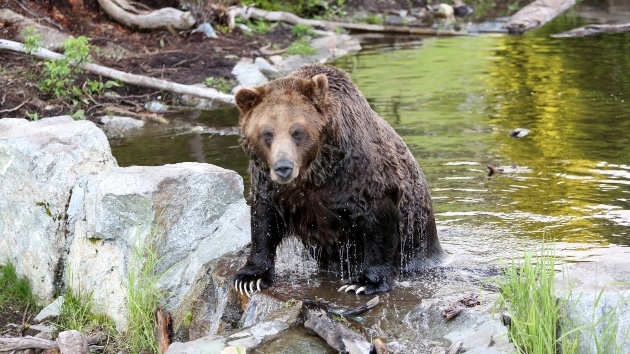Fueling Wimbledon: What it’s like to feed half-a-million people at the world’s most renowned tennis event
Written by ABC Audio ALL RIGHTS RESERVED on July 1, 2024

(LONDON) — Imagine hosting a party for more than half a million people where you had to manage 3,000 staff, more than 55 kitchens and nearly 300 chefs in one of the largest catering operations in the world, all while making sure everybody gets what they want so they leave happy and full?
This is where Perdita Sedov comes in.
The Championships at Wimbledon, held annually in southwest London for over 150 years, is an absolute behemoth of an event in the world of tennis. And in the culinary world, it doesn’t get much bigger either.
Wimbledon is the largest single annual catering operation in Europe, according to the tennis body. Sedov — who is the head of food and drink for the event — works year-round going over every single culinary detail to make sure that the event not only goes off without a hitch, but that it actually enhances people’s experiences.
“Ultimately, it’s really about making sure that when you come to Wimbledon, which is a bucket list event for so many people who may only get to visit once in their lifetime, you feel your experience through food and drink as well as what you experience watching the tennis,” Sedov told ABC News.
From a management perspective, the numbers are staggering. In 2023, Wimbledon served a total of 281,151 hot meals at the two-week event, along with more than 50 tons of strawberries, 14,968 liters of dairy cream and 102,144 scones to go with it.
And what would Wimbledon be without the drinks. At least 257,381 cups of tea were served in 2023, a number that pales in comparison to the 341,202 glasses of Pimm’s and lemonade that were consumed courtside.
But, for Sedov, the biggest pressure comes in deciding what to serve to her demanding and increasingly international clientele while making sure there are options that fit the dietary requirements of every single person that walks through the front gates of Wimbledon. How do you deliver everything for everyone when they want something different and manage to exceed their expectations while doing it?
“There will be guests who come to the event and want what is deemed as ‘traditional British food,’ like fish and chips,” Sedov said. “Then there’ll be someone who wants to come and try a bit more of cutting-edge food or a bit of food that is more trend and we want to make sure we have that complete range and that we’re not a kind of one trick pony.”
It starts with showcasing the best of what British food is and can be by always serving the finest ingredients that are in season and, perhaps more importantly, not just sticking to traditions but pushing them forward in new directions.
“British food can be quite simple and quite traditional, but I think we’re also hugely influenced here in the United Kingdom. We have so many different cultures and different mixes of people and the great thing is that everyone brings their own take on foods,” Sedov said. “There is the classic example of chicken tikka masala. Why do we have it here? Because it was taking Indian food and tailoring it to the British taste. But everything is growing up now, so I think the nice thing about British food is there’s almost no limits to it. It’s really about hospitality and showcasing that Britain produces some really great food, some great farming, great cheeses, strawberries, animals and a big part of that is representing it well.”
This is clearly reflected when you come onto the grounds of Wimbledon and see the sheer amount of choice available to patrons across the 42-acre site.
“We’re really mindful that while we are the British tennis tournament, our players, our guests, and many people are coming from all over the world, so we also want to showcase a bit of what’s happening from beyond our borders,” Sedov said. “This year, for example, we’ve got a new poké bowl option, we’re doing Korean fried chicken, we’ve got tofu options, but we’ve also got our fish and chips, our fish finger sandwich, easy yet delicious items like hamburgers and hotdogs and even a plant-based no pastrami bagel. In fact, one of our most popular sandwiches is ham and cheese. Just really simple. Not everything has to be all about the bells and whistles.”
In the past several years, Wimbledon has turned toward a model of sustainability which is now an “integral focus within all planning and delivery of food and drink across The Championships and throughout the year-round operation,” the tennis organization said.
Not a single ingredient arrived at The Championships via airfreight in 2023, something Wimbledon plans to make a permanent fixture going forward.
“We source responsibly, working with suppliers to ensure the very best for our guests, environment, and ingredients. We buy only free-range eggs, use only Fairtrade sugar, and are committed to the Sustainable Fish Cities campaign,” Wimbledon told ABC News. “Additionally, our partnership with food rescue organization City Harvest continues and it looks to ensure food is not wasted and instead redistributed locally. We also make donations seasonally to local food banks within the community.”
Sedov worked as an English teacher living abroad in Mexico, Cambodia and several places in Africa, before turning to food and working in chain restaurants. She then worked at independent establishments and, ultimately, became a policy consultant before ending up at Wimbledon for the past seven years. She said her job is about finding a common ground and constantly tweaking things to find the perfect balance.
“Food is such a common language and bond for people. It’s kind of that simple, even if you can’t speak the same language. I have always been interested in food,” Sedov said. “The reason I just love working at Wimbledon is it is such a different way of doing food and drink. You’re trying to feed players, members, tourists, colleagues, public guests, all these different people who need different things from their food.”
“Players need it to actually be a fuel for them. They’re looking for very specific diets, ingredients and details versus someone who maybe wants to try British food for the first time and who wants to get their hands on Wimbledon’s strawberries and cream and experience the local fare,” Sedov continued. “It’s fascinating.”
But even though every element of the tournament looks and feels pristine, from the grass on court to the plants on the grounds to the food on people’s plates, there is always a way to make tiny improvements — another step to take on a constant path to perfection.
“In 2015, the gap between the French Open and Wimbledon changed from two weeks to three weeks,” Sedov said. “When that happened, the strawberries we had been buying were not going to be at their peak for the second week of the tournament. So what did we do? We changed the whole variety of strawberries we bought so they would be perfectly in season.”
Copyright © 2024, ABC Audio. All rights reserved.
 KVSP
KVSP 




